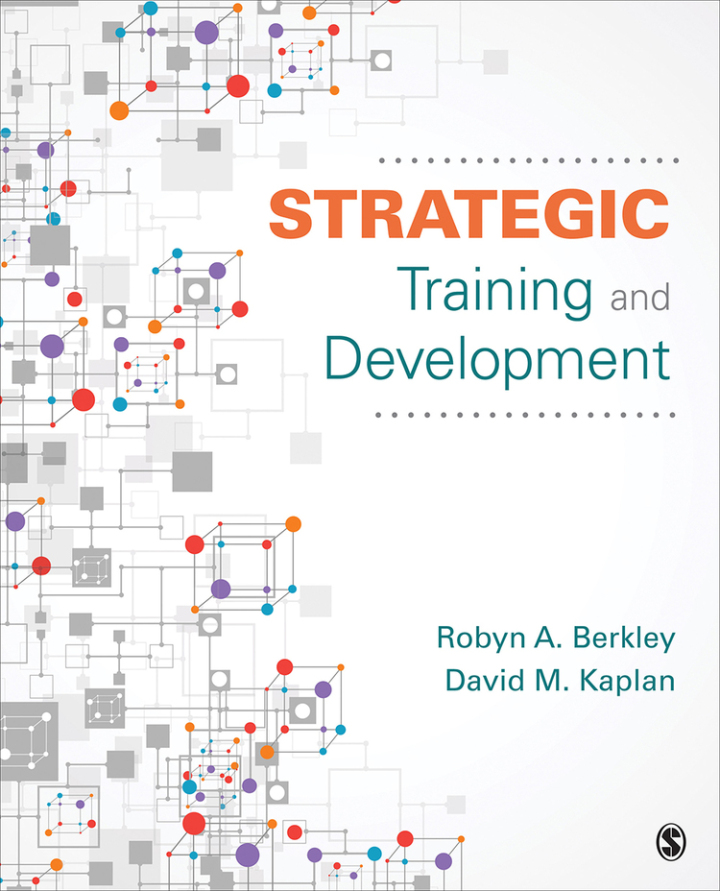
Strategic Training and Development 1st Edition
PUBLISHER: Sage
Trường ĐH, Nhóm, Thư Viện: Gọi 0915920514 để báo giá eBook hosting trên Vital Source hoặc mua Sách In
Đào tạo và phát triển chiến lượcCon người là nguồn lực quan trọng nhất đối với các tổ chức ngày nay. Các tổ chức phải đầu tư vào nhân viên của mình để duy trì lợi thế cạnh tranh và đạt được các mục tiêu chiến lược của mình. Đào tạo và Phát triển Chiến lược biến lý thuyết và nghiên cứu thành những phương pháp thực hành tốt nhất để nâng cao kiến thức, kỹ năng và hành vi của nhân viên tại nơi làm việc. Các tác giả Robyn A. Berkley và David M. Kaplan áp dụng cách tiếp cận toàn diện và mang tính trải nghiệm, mang đến nhiều cơ hội thực hành phong phú cho sinh viên. Sự tập trung mạnh mẽ vào công nghệ, đạo đức, các vấn đề pháp lý, sự đa dạng và hòa nhập cũng như sự kế thừa giúp chuẩn bị cho sinh viên thành công trong môi trường kinh doanh ngày nay.
- PrefaceAcknowledgmentsAbout the AuthorsIntroduction to Training and DevelopmentIntroductionThe Instructional Systems Design ModelAnalyzeDesignDevelopImplementEvaluateADDIE Model in Our TextbookTraining and Development Career IssuesInterest Profile for TrainersCareer Outlets for Training and DevelopmentProfessional Organizations and CertificationsConclusionKey TermsEnd-of-Chapter Exercises
- CHAPTER 1 • Training and Development StrategyLearning ObjectivesInternal EnvironmentTasksPeopleSocialOrganizationInterdependence of the Internal EnvironmentHR InfrastructureCompany StrategyAligning Company and Training StrategiesCorporate Strategy TheoriesExternal EnvironmentEconomic EnvironmentPolitical-Legal EnvironmentTechnological EnvironmentSociocultural EnvironmentEthics and Training StrategyGlobal Issues in Training StrategyChapter SummaryKey TermsEnd-of-Chapter Questions and Exercises
- CHAPTER 2 • Legal Issues in Training and DevelopmentLearning ObjectivesJurisdiction and EthicsWhat If a Law Does Not Apply?Equal Employment OpportunityCivil Rights ActAmericans With Disabilities Act (ADA)Age Discrimination in Employment Act (ADEA)Affirmative ActionLiability and the Provision of TrainingSafety and HealthAffirmative DefenseIndependent ContractorsChapter SummaryKey TermsEnd-of-Chapter Questions and Exercises
- CHAPTER 3 • Needs AnalysisLearning ObjectivesOrganization LevelOrganizational AlignmentA Training SWOTJob LevelTask-Based or Competency-BasedMethodsSourcesPerson LevelConducting a Person-Level AnalysisMotivation TheoriesResults of a Needs AnalysisLearning ObjectivesWhy Not to TrainChapter SummaryKey TermsEnd-of-Chapter Questions and Exercises
- CHAPTER 4 • Learning TheoriesLearning ObjectivesBloom’s Taxonomy: What People LearnLearning TheoriesBehaviorismCognitivismConstructivismHumanismPedagogy, Andragogy, and HeutagogyPedagogy Versus AndragogyHeutagogyLearning StylesAre There Generational Differences in Learning?Chapter SummaryKey TermsEnd-of-Chapter Questions and Exercises
- CHAPTER 5 • Training Evaluation: Reaction and LearningLearning ObjectivesTraining Strategy for EvaluationHow Training Strategy Informs Training EvaluationLearning Evaluation StrategyDeveloping Learning ObjectivesPlanning ObjectivesWriting ObjectivesQuantifying ObjectivesTraining Design for EvaluationNonexperimental DesignsExperimental DesignsTraining Design for Evaluation SummaryReliability and Validity of Training MeasuresKirkpatrick’s Model for Training EffectivenessTraining Evaluation AdministrationLevel 1: ReactionLevel 2: LearningChapter SummaryKey TermsEnd-of-Chapter Questions and Exercises
- CHAPTER 6 • Training Evaluation: Transfer and ResultsLearning ObjectivesTransferring Learning to BehaviorStrategic FocusThe Right Kind of LeadershipThe Ability to Plan For and Manage Change EffectivelyAn Effective Measurement SystemSuccess at Levels 1 and 2Kirkpatrick’s Model for Training EffectivenessLevel 3: BehaviorLevel 4: ResultsTransfer of TrainingNear Versus Far TransferFactors Affecting TransferTraining Evaluation AnalysisTraining BudgetsChapter SummaryKey TermsEnd-of-Chapter Questions and Exercises
- CHAPTER 7 • Learning MethodsLearning ObjectivesTraditional MethodsLectureDiscussionExperiential MethodsDebriefsCasesRole PlaysIn-BasketGamesSimulationsChoosing a MethodInstructional AidsOverheads and HandoutsBlackboards, Whiteboards, and ComputersFlipchartsVideo and AudioAsking QuestionsQuestion to ConfirmQuestion to EngageHow to Ask QuestionsChapter SummaryKey TermsEnd-of-Chapter Questions and Exercises
- CHAPTER 8 • Delivery Options for Face-to-Face TrainingLearning ObjectivesInstructional SettingsOn-SiteOff-SiteUnspecifiedFactors Influencing Selection of Instructional SettingsControl/StandardizationFidelityCostsSocial CapitalReward ValueOn-the-Job Training (OJT)Trainer SelectionTrainer SupportTraining DesignTraining EvaluationWorkshops, Speakers/Courses, Conferences, and Corporate UniversitiesFeatures of ClassroomsFeatures of Programs and ProvidersCorporate UniversityChapter SummaryKey TermsEnd-of-Chapter Questions and Exercises
- CHAPTER 9 • Technology-Mediated Training and DevelopmentLearning ObjectivesTechnology-Facilitated LearningCommunicating VirtuallyConcerns With Virtual CommunicationOpportunities With Virtual CommunicationHuman Resource Information Systems (HRIS)Needs AnalysisSuccession PlanningTraining and Development DeliveryTraining EvaluationOnline InstructionCharacteristics of Online InstructionMobile InstructionGamificationMassive Online Open Courses (MOOCs)e-Mentoring and e-CoachingChapter SummaryKey TermsEnd-of-Chapter Questions and Exercises
- CHAPTER 10 • Careers and SuccessionLearning ObjectivesCareer TheoriesCareer StagesExplorationEstablishmentMaintenanceObsolescencePlateausCareer End or TransitionCareer PathsMobility PatternsPredictability and Managing CareersTraditional, Protean, and Boundaryless CareersTraditionalBoundarylessProteanCareer AnchorsSuccession PlanningApproaches to Succession PlanningMethods and Tools to Conduct Succession PlanningNew Careers and Succession PlanningChapter SummaryKey TermsEnd-of-Chapter Questions and Exercises
- CHAPTER 11 • Employee DevelopmentLearning ObjectivesStrategic Importance of DevelopmentLearning AgilityEmployee DevelopmentAssignments and Enrichment OpportunitiesJob DesignJob TransitionsMentoring and CoachingLeadership DevelopmentChapter SummaryKey TermsEnd-of-Chapter Questions and Exercises
- CHAPTER 12 • Practical Skills for Training and DevelopmentLearning ObjectivesCommunication StyleNonverbal CommunicationImprovisational CommunicationListeningPassive ListeningAttentive ListeningActive ListeningFeedbackConflict ResolutionLess Effective Conflict Resolution StylesMore Effective Conflict Resolution StylesSelf-AwarenessEmotional IntelligenceChapter SummaryKey TermsEnd-of-Chapter Questions and Exercises
- CHAPTER 13 • Training for Differences: Understanding Culture and DiversityLearning ObjectivesHow People, Organizations, and the Global Context DifferMacro-Level Differences: National Culture and Global CompetencyNational CultureTraining Employees for International AssignmentsOrganization-Level Differences: Company CultureArtifactsEspoused ValuesBasic Underlying AssumptionsOnboarding to Train for Organizational CultureRecruitmentOrientationGeneral Program AttributesMicro-Level Differences: Individual Differences and Diversity TrainingTypes of DiversityApplying Practical T&D Skills to Diversity TrainingEthics and Training Diverse OthersChapter SummaryKey TermsEnd-of-Chapter Questions and ExercisesAppendix A: Semester-Long ProjectAppendix B: External PartnershipsAppendix C: Managing a Training SessionGlossaryNotesIndex















